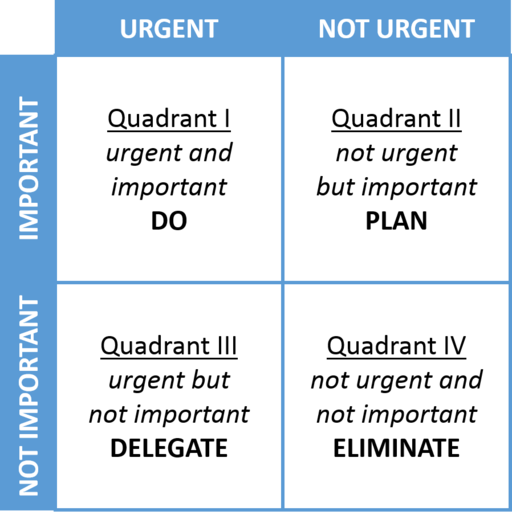Improving Time Management as a Solo Entrepreneur
Time management is a critical skill for solo entrepreneurs. You have a lot of tasks to do, from product development to marketing, and everything in between.
Therefore, how you manage your time can significantly impact your productivity and business growth.
There are only 24 hours in a day and you have to use the time effectively to grow your business.
This makes it crucial for solo entrepreneurs to implement effective time management strategies that maximize their productivity while balancing their personal and professional lives.
In this article, we explore various proven techniques that can help solo entrepreneurs improve their time management skills.
We delve into strategies like creating a daily schedule, using the 2-Minute Rule, making a prioritization and delegation matrix, and much more.
Each section provides practical advice on implementing these techniques, along with insights into their benefits for your business.
These strategies can help you increase your productivity, and grow your business.

Create a daily schedule and Schedule “everything”!
Creating a daily schedule as a solo entrepreneur is an invaluable practice that can drastically improve your productivity and efficiency.
Begin by scheduling your most important tasks, followed by secondary tasks. This practice ensures that even if your day doesn’t go as planned, your key tasks will still be addressed.
But remember, it’s not just about work.
Be sure to include breaks, meals, exercise, and personal time in your schedule. Also, allow for buffer time between tasks to account for the unexpected. This way, you balance your professional and personal life while preventing burnout.
Utilizing digital tools like Google Calendar, Asana, or Trello can facilitate this process. They provide you with an overview of your day and allow you to rearrange tasks easily.
With this consistent scheduling practice, you create a powerful habit that aids in better time management, ultimately contributing to your success as a solo entrepreneur.

Map out tasks the day before
Planning your tasks the day before can provide a clear roadmap for your day and help reduce procrastination.
You will start your day with a clear focus and not wasting time figuring out what to do.
Your plan can include your top priorities for the day, scheduled appointments, and time for breaks.
Remember, while planning is crucial, it’s also essential to maintain flexibility for unexpected tasks or changes in your schedule.

Start your day earlier than everyone else
Waking up early allows you to have undisturbed time to work on your tasks. There are fewer distractions and interruptions early in the morning as the rest of the world is still waking up.
Creating a productive morning routine can kickstart your day. You could use this time for strategic planning, learning new skills, exercising, or meditating.
Remember, the goal is to use the time effectively.
Make sure you have a plan for your morning so that you don’t waste time.

Identify high-impact tasks
High-impact tasks are those that contribute significantly to your business goals. Identifying and focusing on these tasks can lead to higher productivity and greater business growth.
To identify these tasks, consider your business goals and ask yourself which tasks will help you achieve them.
These tasks should be prioritized in your schedule.
This will ensure that your time and effort are spent in the best way to grow your business.
Group related tasks together
One effective time management technique is grouping related tasks together, also known as task batching.
By doing this, you reduce the time and energy lost in task-switching.
For instance, schedule blocks of time for similar tasks, such as responding to emails, making phone calls, or creative work.
This can help to improve your workflow and reduce mental fatigue, as your brain isn’t continuously having to switch between different types of tasks.
Remember to be flexible with this technique.

Time block
Time blocking is a time management method where you divide your day into blocks of time. Each block is dedicated to accomplishing a specific task or group of tasks.
This method forces you to concentrate on one task at a time. It also helps reduce the negative effects of multitasking and task-switching.
One effective way of time blocking is to assign themes to certain days.
For instance, you might dedicate Mondays to marketing, Tuesdays to product development, and so on. This can create a productive routine and ensure that all areas of your business get the attention they need.
Work in sprints
Working in sprints, or short bursts of focused work, can enhance productivity. This technique involves working intensely on a task for a set period, followed by a short break. It’s similar to the Pomodoro Technique but can be adapted to long periods of work and break times.
Working in sprints can maintain your focus, boost your productivity, and prevent burnout by ensuring you take regular breaks.
It’s a flexible method that can be adapted to suit your personal productivity patterns and the nature of the tasks at hand.

Do the most important tasks in the morning
Your productivity levels and mental energy are typically at their peak in the morning. Therefore, tackling your most important tasks in the morning can lead to better quality work and a higher level of productivity.
By completing your most crucial tasks early, you also ensure that they get done.
As the day progresses, unexpected issues can arise, and energy levels can drop, which could prevent important tasks from being completed if they are left until later.
Take advantage of your fresh and alert state in the morning to focus on the tasks that will make the most significant impact on your business.
This strategy gives you a few wins that will motivate you for the rest of the day.
Do the simplest tasks first
While it’s beneficial to complete important tasks in the morning, starting your day with a few simple tasks can also be helpful.
Especially if you struggle with procrastination.
This technique, often referred to as “quick wins,” can provide a psychological boost and momentum to take on more challenging tasks.
These simple tasks could be as easy as organizing your workspace or updating your to-do list. Completing them gives you a sense of progress and achievement early in the day, which can inspire you to tackle more complex tasks.
Remember, the objective is to use these quick wins to fuel your productivity, not to distract you from doing high-impact tasks.
Be careful to avoid using simple tasks as a form of procrastination.
Make Prioritization and Delegation Matrix
As a solo entrepreneur, your task list can seem never-ending. Therefore, it’s crucial to make a prioritization and delegation matrix. This technique helps identify tasks that are essential and urgent and those that can be deferred, delegated, or even deleted.
You can use the Eisenhower Box, a simple decision-making tool, to do this.
It consists of four quadrants: urgent and important tasks, important but not urgent tasks, urgent but not important tasks, and tasks that are neither urgent nor important.
This matrix can help you focus on the tasks that align with your long-term goals and delegate or eliminate the rest.
Over time, this practice will help you develop a sharp eye for prioritizing tasks and ensure your efforts are targeted towards tasks that matter the most.

The 2-Minute Rule
The 2-Minute Rule, coined by productivity expert David Allen, is a simple yet highly effective time management strategy. If a task takes two minutes or less to complete, it should be done immediately.
This technique prevents small tasks from piling up and becoming a significant drain on your time.
The beauty of the 2-minute rule is that it doesn’t require significant effort or time, but it can lead to massive productivity boosts over time.
By using this rule, you can reduce your to-do list and free up time for more important tasks.

Outsource as Much as Possible
You may be tempted to handle every aspect of your business. However, this approach can lead to exhaustion and decreased productivity.
It’s crucial to outsource tasks that don’t necessarily need your expertise.
Tasks such as bookkeeping, social media management, and customer service can often be outsourced.
This allows you to focus on tasks that drive your business forward. Outsourcing has several benefits, including freeing up your time, bringing in expert knowledge, and allowing for scalability.
It’s important to remember that outsourcing is an investment. It frees up your time to focus on strategic growth and high-impact tasks and can make it a worthwhile investment.

Find Ways to Automate
Automation can save a significant amount of time and energy for solo entrepreneurs. From email responses to social media posts and invoicing, there are numerous tasks you can automate using various software and applications.
It helps eliminate repetitive tasks, reduces the chance of human error, and allows you to focus on core business functions.
Research the best tools available for your specific needs and see where automation can be beneficial.
Keep in mind, it doesn’t replace the human touch needed for tasks like building customer relationships and making critical business decisions.

Say no more
Learning to say “no” is an essential skill.
Your time is limited, and ensuring that it’s spent effectively is crucial. This might mean declining tasks, projects, or activities that don’t align with your business goals or take up too much of your time.
Saying no can be difficult, especially when opportunities seem appealing.
By saying no to less important tasks, you can dedicate more time to those that truly matter.

Use the Pomodoro Technique
The Pomodoro Technique was developed by Francesco Cirillo in the late 1980s. The technique uses a timer to break work into intervals, traditionally 25 minutes in length, separated by short breaks.
This method can help improve concentration and productivity while reducing the fatigue caused by long work periods.
Each interval, known as a “Pomodoro,” should be fully dedicated to one task.
After each Pomodoro, take a five-minute break to rest your brain. Limit the use of screens in your 5-minute break. Grab a snack, stretch or just move a little.
After completing four Pomodoros, take a longer break of 15-30 minutes.
Do a Google search for “Pomodoro timer” and you will find several free versions.
Use the Eisenhower Matrix
The Eisenhower Matrix, also known as Urgent-Important Matrix, is a powerful tool for effective time management. It helps you prioritize tasks based on their urgency and importance, sorting out less urgent and important tasks which you should either delegate or not do at all.
The matrix consists of four quadrants:
- Urgent and important (tasks you will do immediately).
- Important, but not urgent (tasks you will schedule to do later).
- Urgent, but not important (tasks you will delegate to someone else).
- Neither urgent nor important (tasks that you will eliminate).
By using the Eisenhower Matrix, you can ensure you’re dedicating your time and energy to the tasks that truly matter, leading to more productivity and effective time management.

Allocate Unstructured Time
While scheduling and structuring your day can significantly enhance productivity, it’s equally crucial to allocate unstructured time. This is time without any planned activities, allowing for spontaneity and flexibility.
Unstructured time can be used for brainstorming new ideas, reflecting on your strategies, solving complex problems, or even relaxing and rejuvenating. It encourages creativity and innovation, which are essential for business growth and success.
The aim is not to pack every minute of your day with structured activities but to maintain a balance between structured and unstructured time.
Conduct a Time Audit
Conducting a time audit involves tracking your activities and how much time you spend on them over a specific period. This practice provides valuable insights into where your time goes, helping you identify time wasters and areas for improvement.
There are numerous tools and apps, like RescueTime or Toggl, that can automate this process for you.
When you understand how you use your time, you can make informed decisions on where to focus your efforts.

Final Thoughts
It’s easy to become overwhelmed and lose track of the most important tasks.
By using the time management strategies we’ve outlined, you can significantly boost your productivity, reduce stress, and create more time for the activities that matter most.
Whether it’s creating a daily schedule, using the 2-Minute Rule, prioritizing tasks with the Eisenhower Matrix, or taking advantage of time-blocking, each of these strategies can be a powerful tool in your entrepreneurial arsenal.
However, remember that what works best will depend on your unique working style and business needs.
Continuously evaluate and adjust your time management strategies as necessary.
Remember, the goal is not to fill every minute with tasks but to spend your time effectively on high-impact activities that contribute to your business’s success.
In the end, effective time management is about working smarter, not harder.
By managing your time, its also easier to maintain a healthy work-life balance.
Embrace these strategies, and watch as you create more structure, productivity, and success in your journey as a solo entrepreneur.
Good luck!
Frequently Asked Questions
How do solo entrepreneurs manage time?
Solo entrepreneurs manage time through a combination of careful planning, prioritization, and employing efficient strategies. They create daily schedules, apply rules like the 2-Minute Rule, group related tasks together, and start their days early. Techniques like the Pomodoro Technique, the Eisenhower Matrix, and time blocking are also common tools. Delegation, outsourcing, automation, and regular time audits also play crucial roles in effective time management.
What are the 4 P’s of time management?
The 4 P’s of time management are Planning, Prioritizing, Productivity, and Proactiveness. Planning involves scheduling tasks and setting goals, while Prioritizing entails deciding the importance and urgency of tasks. Productivity implies efficient use of time, while Proactiveness suggests acting in advance to prevent possible time-wasting situations.
How can an entrepreneur overcome time management?
Overcoming time management challenges involves a mix of strategies. Prioritization is key: it involves determining which tasks have the most significant impact and focusing on them first. Other methods include delegating tasks that others can do, automating processes where possible, and employing productivity techniques like time blocking and the Pomodoro Technique.
How do you manage your time independently?
Managing time independently requires discipline and strategic planning. This can be done by creating a daily schedule, using time-management techniques such as time blocking and the Pomodoro technique, and employing the Eisenhower Matrix for prioritization. It’s also important to allow for flexibility and unstructured time to encourage creativity and prevent burnout.
What are the 5 keys to time management?
The 5 keys to time management are Goal Setting, Prioritization, Planning, Delegation, and Flexibility. Goal Setting involves defining what you want to achieve, while Prioritization determines the order of tasks based on their importance. Planning organizes your tasks, while Delegation allows others to assist with tasks to free up your time. Lastly, Flexibility allows for adjustments when unexpected events occur.
What are the 5 principles of time management?
The 5 principles of time management are Identify Goals, Prioritize Tasks, Plan Ahead, Stay Organized, and Learn to Delegate. These principles require one to have a clear understanding of what needs to be achieved, set priorities accordingly, allocate time for tasks, keep everything in order, and distribute tasks when possible.
Why do entrepreneurs need time management skills?
Entrepreneurs need time management skills to maximize their productivity, achieve their goals, and maintain a healthy work-life balance. Good time management allows entrepreneurs to stay focused, reduce stress, make better decisions, and ultimately drive their business success.
How do I schedule my day when I own a small business?
Scheduling your day when you own a small business involves breaking your day into manageable chunks or time blocks. Start with your most critical tasks in the morning, followed by simpler tasks. Group similar tasks together and allocate time for breaks to avoid burnout. Also, consider using productivity techniques like the Pomodoro Technique to maintain focus.
What is the 3 3 3 method for managing time?
The 3-3-3 method for managing time divides your day into three sections: the first 3 hours of the day, the next 3 hours, and the last 3 hours. This method suggests you focus on your most important tasks during the first three hours when you’re most productive, handle less urgent tasks in the next three hours, and wrap up and prepare for the next day in the last three hours.
What are the 3 types of time management?
The three types of time management are the time set for important tasks, the time allocated for urgent tasks, and the time spent on non-urgent and non-important tasks.
Using tools like the Eisenhower Matrix can help in effectively distinguishing and managing these three types of tasks.
What is the first step in improving your time management?
The first step in improving your time management is conducting a time audit. This involves tracking how you spend your time throughout the day to identify any time-wasting activities or inefficiencies. From there, you can better plan and prioritize your tasks.
How do entrepreneurs spend their free time?
Entrepreneurs spend their free time in various ways depending on personal preferences. Some might use it to relax and recharge, others may pursue hobbies or personal interests. Some entrepreneurs use this time for networking, personal development, or strategizing for their business.
How do you manage a solo business?
Managing a solo business involves good time management, strategic planning, effective prioritization, and a willingness to delegate or outsource tasks when necessary. It also involves staying organized, automating tasks where possible, and maintaining a balance between work and personal life.
Do entrepreneurs set their own hours?
Yes, entrepreneurs generally have the flexibility to set their own hours. However, they often end up working longer hours than traditional employees due to the demands of running a business. It’s important for entrepreneurs to manage their time effectively to maintain a healthy work-life balance.
Can an entrepreneur work alone?
Yes, an entrepreneur can work alone, and those who do are often referred to as “solopreneurs.” However, even solopreneurs need to delegate and outsource tasks occasionally to focus on their core business functions.
What does an entrepreneur spend most of the time?
Entrepreneurs spend most of their time on high-impact tasks that drive their business forward. This may include strategic planning, marketing, product development, customer relations, networking, and more. The exact distribution of time will depend on the nature of the business and the entrepreneur’s role within it.
What key activities should entrepreneurs invest their time in?
Entrepreneurs should invest their time in activities that yield the highest return for their business. These include strategic planning, innovation, networking, customer relationship management, learning and development, and marketing activities.
What do entrepreneurs do all day?
Entrepreneurs’ daily activities vary based on the nature of their business. They might spend time strategizing, meeting with clients or team members, working on marketing strategies, reviewing financials, or handling operational tasks. They also invest time in learning and staying updated with industry trends.
How do I stay organized when starting a business?
Staying organized when starting a business involves creating a detailed business plan, setting clear goals, and maintaining an organized workspace. Use productivity tools for task management, time tracking, and document organization. Regular audits of your time and processes also help to identify areas for improvement.
What is the difference between Solopreneur and entrepreneur?
The main difference between a solopreneur and an entrepreneur lies in their team. Solopreneurs manage all aspects of their business themselves, while entrepreneurs may delegate tasks to a team. Both are business owners, but solopreneurs prefer to work alone, while entrepreneurs often work with others.
What is a single business-level strategy?
A single business-level strategy refers to a plan that involves one standalone line of business or product. This strategy is usually adopted by small businesses or solopreneurs and focuses on achieving a competitive advantage within a specific market or industry.








2 Comments
Comments are closed.